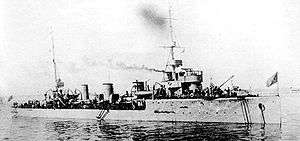Soviet destroyer Yakov Sverdlov
 Yakov Sverdlov | |
| History | |
|---|---|
| Name: | Yakov Sverdlov |
| Namesake: | Yakov Sverdlov |
| Builder: | Putilovsky Plant, St. Petersburg |
| Acquired: | November 1917 |
| Out of service: | 9 September 1918—1925 |
| Renamed: | 1923 |
| Reclassified: | 23 April 1940 as training ship |
| Refit: | 28 November 1937—8 December 1940 |
| Reinstated: | 23 June 1941 |
| Fate: | Sunk by a German mine on 28 August 1941 |
| General characteristics after 1929 rebuild | |
| Type: | Destroyer |
| Displacement: | 1,597 tonnes (1,572 long tons; 1,760 short tons) |
| Length: | 102.4 m (335 ft 11 in) |
| Beam: | 9.5 m (31 ft 2 in) |
| Draught: | 3.5 m (11 ft 6 in) |
| Propulsion: |
|
| Speed: | 32 knots (59 km/h; 37 mph) |
| Endurance: | 1,800 nmi (3,330 km) at 12 knots (22 km/h) |
| Complement: | 168 men |
| Sensors and processing systems: |
|
| Armament: |
|
Yakov Sverdlov was a destroyer of the Soviet Navy that served in the Baltic Fleet during World War I and World War II. Originally known as Novik, she was renamed Yakov Sverdlov in 1923. She was a training ship when Operation Barbarossa began, but was recalled to active duty the following day. She struck a mine on 28 August 1941 and sank while escorting an evacuation convoy from Tallinn to Kronstadt.
History
On 26 October 1917 Novik's crew joined the Bolsheviks, although nothing is known of her activities, if any, under their control during World War I.[1] She was laid up from 9 September 1918 until 1925 when she was extensively rebuilt between 26 September 1925 and 30 August 1929. Her rearmost set of twin torpedo tubes was removed, the three 102 mm (4.0 in) guns on the quarterdeck were moved forward and a 76.2 mm (3.00 in) "Lender" anti-aircraft gun was mounted at the very rear of the quarterdeck, which seriously obscured the arc of fire of the rear 102 mm gun. The three remaining twin sets of torpedo tubes were exchanged for triple launchers and re-positioned, a net increase of one torpedo tube. The bridge structure was enlarged and the deckhouse immediately aft of the fourth funnel was removed and a new, larger deckhouse was added about 9 metres (30 ft) aft of the fourth funnel. The masts were re-positioned and reinforced with supporting legs while the forward funnel was heightened by 2 metres (6.6 ft).[2]
She was overhauled between 28 November 1937 and 8 December 1940, although what exactly this involved is not clear. She probably had her machinery overhauled or replaced and between two and four single 45 mm (1.8 in) 21-K anti-aircraft guns were installed. Before her refit was completed, however, she was re-designated as a training ship on 23 April 1940.[2]
At the start of the war, she was reassigned to the Third Destroyer Division of the Baltic Fleet. During the evacuation of the Soviet Navy from Tallinn to Kronstadt during Operation Barbarossa, Yakov Sverdlov was assigned as an escort to the flagship Kirov. During the operation, she hit a mine and sank near Cape Juminda on 28 August 1941.[3]
Notes
- ↑ "Destroyer "Novik"" (in Russian). Retrieved 2009-07-25.
- 1 2 Breyer, p. 242
- ↑ Rohwer, p. 95
References
- Breyer, Siegfried (1992). Soviet Warship Development: Volume 1: 1917-1937. London: Conway Maritime Press. p. 168. ISBN 0-85177-604-3.
- Roger Chesneau, ed. (1980). Conway's All the World's Fighting Ships 1922-1946. Greenwich: Conway Maritime Press. ISBN 0-85177-146-7.
- Hill, Alexander (2018). Soviet Destroyers of World War II. Oxford: Osprey Publishing. ISBN 9781472822567.
- Rohwer, Jürgen (2005). Chronology of the War at Sea 1939-1945: The Naval History of World War Two (Third Revised ed.). Annapolis, MD: Naval Institute Press. ISBN 1-59114-119-2.
- Whitley, M. J. (1988). Destroyers of World War 2. Cassell Publishing. ISBN 1-85409-521-8.
External links
| Wikimedia Commons has media related to Destroyer Novik. |
- Yakov Sverdlov on sovnavy-ww2.by.ru (in Russian)
- Yakov Sverdlov on navsource.narod.ru (in Russian)